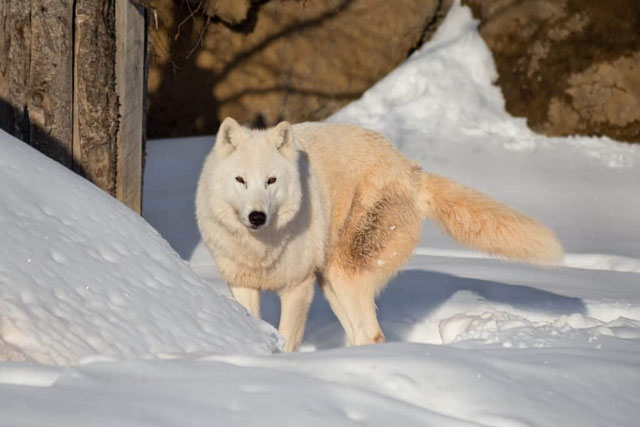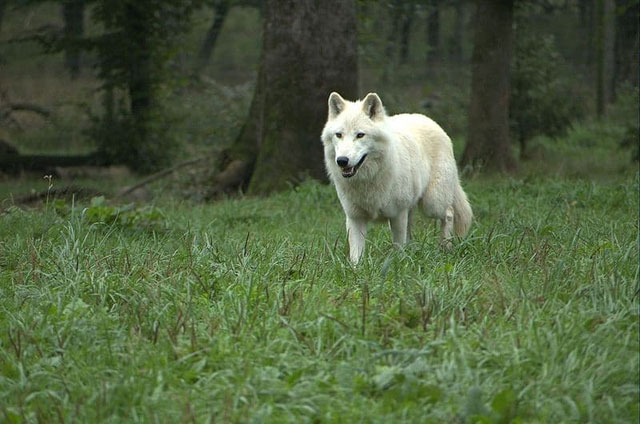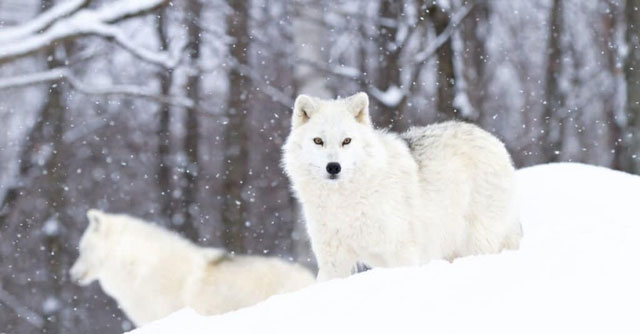Also known as the white wolf, the Arctic wolf (Canis lupus arctos) is a subspecies of the gray wolf. Arctic wolves are found in the Arctic tundra of the Queen Elizabeth Islands, Alaska, Iceland, and Greenland in Canada.
Arctic wolves survive in freezing regions with an average temperature of minus 30 degrees Celsius. They have adapted to the cold with distinct layers of fur, shorter snouts, shorter legs, and smaller ears to retain warmth and insulate against the harsh cold. They can survive for 4 to 5 months without food.
Arctic wolves primarily hunt Arctic hares and lemmings. Occasionally, they also eat Arctic foxes, beetles, birds, and caribou. In return, Arctic wolves are easily preyed upon by polar bears. Bears or other wolves can kill a lone wandering Arctic wolf pup when it strays from the den. Human encroachment into the Arctic wolf’s habitat also poses a threat to them.
Here are some amazing facts about the Arctic wolf that you may not know.
1. Arctic Wolves Communicate Through Sound and Tail Position

They can “call” to each other at any time of the day.
The “pronunciation” of Arctic wolves includes howling, growling, whimpering, and barking. These sounds can be a combination of growls or barks. They can “call” to each other at any time of the day, and it is rare for them to make noise at night. Therefore, if you hear an Arctic wolf howling at night, know that they are trying to communicate with each other for some special reason.
Barking is used as a warning to express aggression when protecting a pack or territory. A mother Arctic wolf may bark to alert her pups when they feel threatened. Growling is also used as a warning signal. However, an Arctic wolf typically growls at intruders to indicate dominance.
Arctic wolves can differentiate between defensive howls and social howls. Females also whimper while nursing. The howls are intended for long-distance communication.
A defensive howl is used to keep or round up pack members and deter intruders. It helps Arctic wolves protect pups that cannot flee from danger.
Wolves often use facial expressions, ear positioning, and tail movements to communicate. A tail curved back and ears pinned back indicate submission. A straight tail and ears perked up or facing forward indicate dominance. Exposed teeth, a wrinkled snout, and ears raised high or low and tilted convey a threatening message.
2. Arctic Wolves Can Endure Complete Darkness

Wolves often use facial expressions, ear positioning, and tail movements to communicate.
In addition to low temperatures, Arctic wolves can survive in extreme darkness. They can endure five months of dark, cold conditions at the poles in a year. They hunt under the light of the Moon and stars, using their sensitive noses to locate prey from miles away.
3. Arctic Wolves Live in Packs of 5 to 7
Arctic wolves are highly social animals and live in packs of 5 to 7 members, sometimes even up to 20. These wolves rarely live alone. They use urine and body scent to mark territorial boundaries.
Each member of the pack has a distinct position in the dominance hierarchy. Tasks are assigned to each member through body posture communication. Typically, the males are the leaders of the pack.
Arctic wolves can run very fast. They can reach speeds of 40 miles per hour when chasing prey. The fastest recorded speed of an Arctic wolf is 46 miles per hour. However, they are not morphologically adapted for high-speed running.

Arctic wolves run very fast.
Arctic wolves are not afraid of humans as they are rarely seen in their habitat. This species can even be tempted to approach people in some areas, which they do out of curiosity and caution. These wolves are not dangerous unless they feel threatened.
4. Arctic Wolves Follow a “Monogamous” Mating System
The dominant males mate with the dominant females and are monogamous. The breeding season occurs around March to April, with females giving birth to 2 to 3 pups in the spring. All members of the group share the responsibility of caring for the young.
Puppies are ready to join the pack at three months old. The father wolf raises the pups by teaching them to play and hunt. By six months of age, they will learn some survival and hunting skills. Females reach reproductive maturity after two years, while males mature at one year old.
5. Arctic Wolves Have Sharp Hearing, Smell, and Vision

Industrial development is also a threat to the Arctic wolf population.
Arctic wolves use their keen hearing, often combined with vision and smell, to monitor their environment and identify potential prey. Their triangular ears rotate independently to hear sounds from distances of 6 to 10 miles, depending on the wind and terrain.
According to some researchers, Arctic wolves can hear sounds at frequencies of 25kHz, with a maximum of 80kHz. However, these wolves begin to go deaf and blind within the first 10 to 14 days of life.
Arctic wolves do not face threats from hunting or mistreatment as they rarely come into contact with humans in the Arctic tundra. However, climate change poses the greatest threat to them. Extreme weather changes in recent years have led to a decline in Arctic hares and lemmings. As a result, this has disrupted the primary food supply for Arctic wolves.
Industrial development is also a threat to the Arctic wolf population. The continuous increase of pipelines, roads, and mines encroaches upon the territory of Arctic wolves, disrupting their food supply.


















































